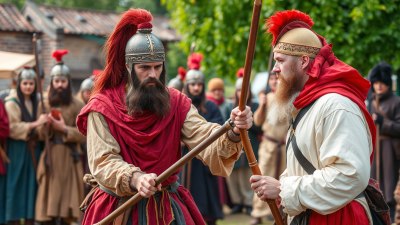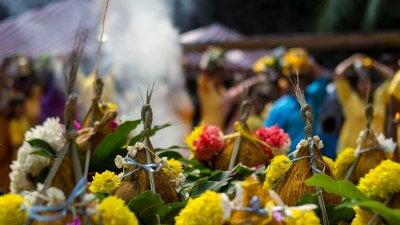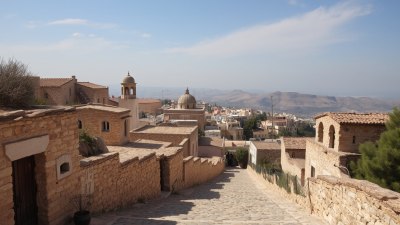Exploring Local Myths Through Historical Reenactments Abroad
Dive into the fascinating world of local myths as depicted through historical reenactments in different cultures.

Image created with Flux Schnell
Historical reenactments serve as a window into the past, allowing us not only to visually connect with bygone eras but also to delve into the myths and legends that shape our cultural narratives. By exploring local myths through these vibrant performances abroad, we can gain deeper insights into the societies from which they originate. This article embarks on a journey across continents, examining various cultural reenactments that bring local myths to life, enriching our understanding of history, folklore, and collective identity.
The Significance of Myths in Culture
Myths are more than mere stories; they encapsulate the beliefs, values, and traditions of a culture. They serve as a tool for education, entertainment, and the preservation of history. In societies around the world, myths provide frameworks for understanding the universe, human existence, and social structures. From the epic tales of heroes and gods to cautionary stories warning against moral failings, these narratives reflect the ideals and struggles of communities. Reenactments give life to these myths, allowing participants and audiences alike to experience and engage with their cultural heritage in a visceral way.
A Journey through Reenactments
As we explore various geographical locations, we come across captivating reenactments that highlight the richness of local myths. These events often blend historical accuracy with theatricality, drawing crowds eager for both education and entertainment. One such event is the Day of the Dead in Mexico, where ancient Aztec traditions are celebrated. This vibrant occasion involves colorful altars, music, and elaborate costumes, embodying mythological themes that acknowledge death and celebrate life.
Embracing Ancient Legends in Europe
In Europe, countless reenactments take place that celebrate local myths. In Scotland, the annual Loch Ness Monster Festival attracts myth enthusiasts from around the globe. Here, reenactors don costumes reflective of the 1930s when the Loch Ness Monster was purported sighted. Through storytelling and performance, participants delve into the myth's origins, connecting it to themes of mystery and belief in the unknown.
The Norse myths have also inspired numerous reenactments. Festivals across Scandinavia celebrate legends of gods like Odin, Freyja, and Thor. These events often involve Viking wrestling, archery, and craftsmanship, alongside storytelling sessions that unfold the epic sagas of creation and battle that characterize Norse mythology. By participating in these historical reenactments, individuals not only learn about ancient societies but also connect with their ancestral roots.
North American Indigenous Myths
In North America, indigenous communities often honor their local myths through cultural festivals and reenactments. For instance, the Powwow is a celebration of Native American culture that showcases traditional dance, music, art, and storytelling. Each powwow serves as an opportunity to share myths passed down through generations, often recounting creation stories or tales of spiritual connection to the land. Such events become alive with the vibrancy of drums and songs, reflecting the strength and resilience of indigenous identities.
Asian Folklore and Historical Reenactments
In Asia, myths are intricately woven into the fabric of society, influencing everything from religion to daily practices. In Japan, the Awa Odori dance festival celebrates the Obon Festival with dances inspired by legends of the dead returning to reunite with their families. Reenactors dress in traditional attire, performing choreographed dances that tell stories from Japanese mythology, such as the moon goddess Tsukuyomi and the sun goddess Amaterasu.
Similarly, in India, the Ram Lila festival reenacts the epic tale of Ramayana. Participants portray various characters from the epic, showcasing moral dilemmas and heroic deeds. As audiences gather for these performances, they not only experience the narrative as entertainment but also engage with profound lessons embedded in Indian culture. These reenactments emphasize the values of duty, righteousness, and devotion, fostering a communal identity.
Bringing Myths to Modern Audiences
As societies continue to evolve, they often retain and adapt local myths, preserving their essence while incorporating modern themes. Reenactments today are not merely historical exercises; they also critique contemporary issues through the lens of mythology. For example, some contemporary Greek theater companies reinterpret ancient myths to address modern themes such as gender equality and environmental concerns. This renewal of classic tales signifies the enduring relevance of myths and their ability to resonate with current societal challenges.
The Role of Technology in Reenactments
Technology significantly alters how historical reenactments are experienced. Virtual reality (VR) and augmented reality (AR) have increasingly been employed to enhance the audience's experience, creating immersive environments that transport participants back to mythical times. These technological advancements allow deeper engagement with the tales, blending the lines between reality and mythology—as audiences can witness epic battles or significant events as if they were truly present.
Furthermore, social media platforms play a critical role in documenting and sharing reenactments worldwide. By broadcasting performances to a global audience, communities can promote their local myths and traditions like never before. Individuals who might never attend these events in person can still be part of the experience, fostering appreciation for diverse cultures and their mythologies.
The Future of Historical Reenactments
As we look to the future, the role of historical reenactments in keeping myths alive is undeniable. They serve as living museums, preserving cultural heritage while promoting critical discourse on history, mythology, and identity. For young generations, participation in such events can spark interest in their cultural history and inspire pride in their heritage.
As myths continue to evolve and adapt over time, these reenactments will play an essential part in ensuring they remain relevant. The storytelling practices embedded within reenactments invite dialogue across generations, allowing individuals to connect deeply with their past while envisioning their future.
In conclusion, exploring local myths through historical reenactments abroad reveals the intricate relationship between culture, storytelling, and identity. These gatherings offer participants and spectators alike an opportunity to engage with the past and celebrate shared narratives. Whether through the colorful festivities of Day of the Dead or the vibrancy of a Norse mythology festival, reenactments provide a bridge connecting us to our cultural roots, encouraging a continuous exploration of the myths that shape our world.











